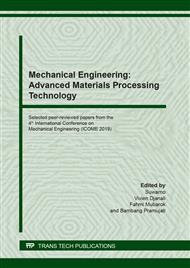p.48
p.54
p.62
p.68
p.75
p.82
p.91
p.98
p.103
Reliability Evaluation of Fatigue Crack Growth Rate of Heat-Treated TIG-Welded Al 6013-t4 by Two-Parameter Weibull
Abstract:
The limited data of fatigue crack growth (FCG) may cause an inaccuracy assessment of the fatigue crack growth rate (FCGR). For particular parts in aircraft such as fuselage skin, a high-reliability degree due to FCG must be determined accurately for the design and safety requirements. Generally, the 6xxx series of aluminum alloy is used as the material for the fuselage skin in the aircraft. In this study, reliability evaluation of FCGR of heat-treated TIG-welded Al 6013-t4 was investigated by two-parameter Weibull. The FCG tests were conducted by following the ASTM E647 under three different artificial aging time conditions of 6, 18, and 24 hours. The C and m constant values were obtained by drawing the regression line from FCG data following Paris’s equation and analyzed employing three methods; the least square fitting method (LSFM), a mean value method (MVM), and a probabilistic distribution method (PDM). The result showed that the PDM and MVM showed a better-fitted line to assess the C and m values than LSFM. From the reliability viewpoints, the two-parameter Weibull was proposed to be applied as the PDM. Furthermore, the MCM was successful in evaluating the probabilistic assessment of the FCGR with the 85% confidence interval.
Info:
Periodical:
Pages:
75-81
Citation:
Online since:
October 2020
Price:
Сopyright:
© 2020 Trans Tech Publications Ltd. All Rights Reserved
Share:
Citation:


